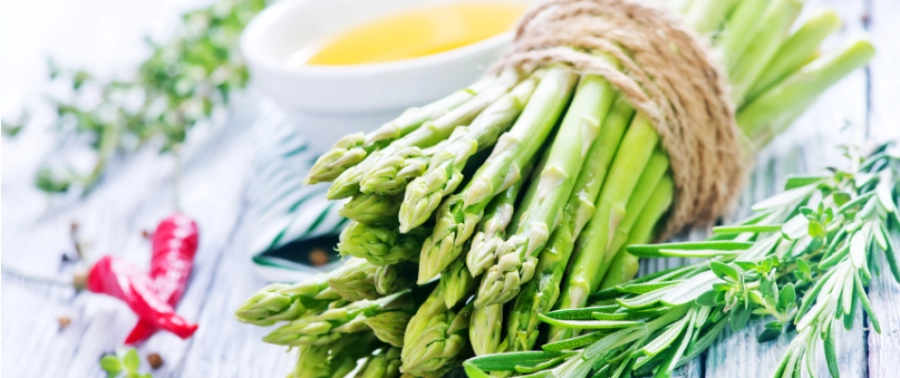
All About Asparagus
A Spring Vegetable for the Nutrition Win
Over dinner last week my family and I had a discussion about asparagus. Namely, how exactly is it good for you? And why does it make your pee smell weird?
So, I dug in to gather details to share with my family and thought you all might be interested, too. Here’s what I found:
Asparagus is a member of the lily family’s low in calories and high in vitamins, minerals, antioxidants, fiber and water. It comes in several different colors (green, white, purple) and big round stalks as well as skinny stalks. It is indeed quite good for you.
Vitamins/Minerals
One half cup of asparagus is 20 calories, a good source of vitamin K (57% RDI, RDI is how much you should eat of something every day). Vitamin K is used for blood clotting, bone complex and more. And folate rings in at 34% RDI, which is very important in pregnancy, cell growth and DNA formation. It’s a moderately good source of vitamin A (18% RDI) and vitamin C (12% RDI) and asparagus is relatively high in potassium (6% RDI). Research shows that eating asparagus contributes to lower blood pressure via potassium in two ways: by relaxing blood vessel walls and increasing salt excretion through urine.
Antioxidants
Asparagus has high levels of flavonoids: quercetin, isorhamnetin and kaempferol, which are do-gooders in the body, protecting us from the effects of oxidative stress and free radicals. Oxidative stress left unchecked contributes to body inflammation, premature aging, and other disease states. Studies found cooking asparagus increases the antioxidant capacity by three times.
Fiber
Half a cup of asparagus gives you 1.8g of fiber or 7% of your daily need. Fiber, both insoluble and soluble, is essential for strong digestive health and asparagus has both kinds, with being a particularly big source of insoluble fiber which helps to bulk up stool and promote regular poops. It does contain insoluble fiber, which feeds large intestine good bugs or microbiome balance, specifically Bifidobacteria and Lactobacillus. We know that strong numbers of these good guys help to strengthen the immune system and help to produce B12 and K2 (I know, quite circularJ).
Asparagus and Weight Loss
Being low in calories, VERY high in water (94%), and a good source of fiber makes asparagus a great choice to include in your meals!
Cooking With Asparagus
It’s easy to incorporate asparagus into meals and snacks.
Asparagus is delicious raw, so snip off the woody ends and use it as a dipper for your favorite dip hummus, guac, white bean dip, etc. For a quick sauté, snip off the woody ends and sauté in a skillet on low with olive oil. Top with lemon and salt and pepper to taste. You can also roast in the oven or steam. NOTE: I have been chopping the asparagus into ½ inch pieces before cooking. It is a touch different, and very delicious, and a very easy colorful side dish to add to the table. I am not a fan of canned asparagus; it’s kind of mushy and contains too much added salt. Go for the fresh, which is in season now, or frozen.
Why Does Asparagus Make Your Pee Smell Weird?
This is a phenomenon called asparagus pee and it happens in some people, but not all. It is the metabolism of asparagusic acid in asparagus that causes the odor. Asparagusic acid is a sulfur-containing compound, and once it is metabolized, it creates several sulfurous byproducts that vaporize easily and evaporate quickly, but not before they make it to your nose when you’re peeing, which can last 8 to 14 hours. This is called the production hypothesis—you produce the sulfurous by-products after eating asparagus. There are genetic modifications that impact whether you can MAKE the smell, but also whether you can ACTUALLY SMELL the smell.
The perception hypothesis states that some can smell for odor that asparagusic acid produces, but others, due to genetic modification, cannot smell the odor. This leads to asparagus pee being bothersome to some, but not all. There you have it.
Overall, asparagus is good for you, and is easy to incorporate into spring and early summer dinners. It is currently at the front of the produce section because it is in season right now, relatively inexpensive, and delicious. So buy it and enjoy it!
Source: Thank you to healthline.com for their wonderful research studies and highlights.
For more healthy tips and recipes, visit healthynestnutrition.com/blog/. Need a hand finding your personalized nutrition plan? Book a free 20-minute consultation with Healthy Nest Nutrition owner Robin Hutchinson to see if our programs are right for you.
